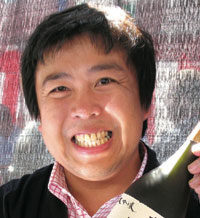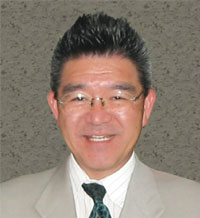Tokyo Jizake Strolling (Strolling to the Shibamata Taishakuten Temple: Part I)
By Ryuji Takahashi
I usually visit the Shibamata Taishakuten Temple in Katsushika ward to pay my first visit of the New Year. The temple is busy on New Year’s Day with many worshippers walking down the approach to the temple, which made it difficult to stroll leisurely through the souvenir shops along the approach to the temple. Long lines also prevented a stop at the dango (sweet dumpling) shop. Therefore, I decided to stroll to the Taishakuten Temple on a weekday and went on a sunny Monday.
From the Keisei-Takasago Station, I boarded the Keisei-Kanamachi Line and rode to the next railway station. Fewer travelers were seen at the railway station and inside the train compared to New Year’s Day. However, foreign tourists and fans of the TV series “Otoko wa Tsurai yo” (It’s Tough Being a Man) were seen here and there. Very few worshippers were seen walking down the approach to the temple, and pedestrian traffic was light enough to stroll leisurely while peeking into souvenir shops on both sides of the approach to the temple.
I first visited the Taishakuten Temple. The official name of the Shibamata Taishakuten Temple is “Kyoei-zan Daikyo-ji,” a Nichiren sect temple built in 1629. This temple was undoubtedly made famous by the TV series “Otoko wa Tsurai yo” (It’s Tough Being a Man), starring Kiyoshi Atsumi and directed by Yoji Yamada. The movie was set at a dango (sweet dumpling) shop and showed scenes at the Taishakuten Temple. Whenever anything happened, a high-ranking monk at the Taishakuten Temple served as the adviser while ringing the temple bell in between.
Tora-san has a famous line, “to give a baby the first bath at the Taishakuten Temple.” Aside from the TV series “Otoko wa Tsurai yo” (It’s Tough Being a Man), the Taishakuten Temple is also famous as a temple of sculptures. The entrance displays the massive Nitenmon Gate. Ten sculptors - Toranosuke Kato, Mitsuharu Kaneko, Koune Kijima, Nobumitsu Ishikawa, Koichi Yokoya, Ginjoro Ishikawa, Shoichi Kafu, Kazuyoshi Yamamoto, Koji Imazeki, and Naomitsu Kobayashi - carved the tale of the Lotus Sutra by hand on the outer wall of the Daikyo-ji Temple, the main building of the Taishakuten Temple from the late Taisho Era (1912-1926) to the early Showa Era (1926-1989). Delicate and exquisitely detailed sculptures, once visible up close, are now covered in glass in a gallery accessible to the public for a fee.
Afterwards, I walked down the connecting corridor and took in the impressively manicured stroll garden “Suikeien.” I first started at the Nitenmon Gate, ducked my head under the Zuiryu Pine Tree as I headed to the main hall, where I paid my respect. White clouds in the blue sky contrasted with the Daikyo-ji Temple and the Zuiryu Pine Tree that lead towards the path of the Buddha, which left me feeling overwhelmed for a while.
I fulfilled my obligatory visit and strolled to where scenes were filmed for the TV series, “Otoko wa Tsurai yo” (It’s Tough Being a Man). I purchased what appeared to be a talisman that Tora-san wore around his neck, then headed to the Tora-san Memorial Museum. It was not noon yet at this point, so I held off on enjoying dango (sweet dumplings) and sake. I look forward to sharing my stories of enjoying sake while walking down the approach to the temple and at the Shibamata Taishakuten Temple in my next report.
From the Keisei-Takasago Station, I boarded the Keisei-Kanamachi Line and rode to the next railway station. Fewer travelers were seen at the railway station and inside the train compared to New Year’s Day. However, foreign tourists and fans of the TV series “Otoko wa Tsurai yo” (It’s Tough Being a Man) were seen here and there. Very few worshippers were seen walking down the approach to the temple, and pedestrian traffic was light enough to stroll leisurely while peeking into souvenir shops on both sides of the approach to the temple.
I first visited the Taishakuten Temple. The official name of the Shibamata Taishakuten Temple is “Kyoei-zan Daikyo-ji,” a Nichiren sect temple built in 1629. This temple was undoubtedly made famous by the TV series “Otoko wa Tsurai yo” (It’s Tough Being a Man), starring Kiyoshi Atsumi and directed by Yoji Yamada. The movie was set at a dango (sweet dumpling) shop and showed scenes at the Taishakuten Temple. Whenever anything happened, a high-ranking monk at the Taishakuten Temple served as the adviser while ringing the temple bell in between.
Tora-san has a famous line, “to give a baby the first bath at the Taishakuten Temple.” Aside from the TV series “Otoko wa Tsurai yo” (It’s Tough Being a Man), the Taishakuten Temple is also famous as a temple of sculptures. The entrance displays the massive Nitenmon Gate. Ten sculptors - Toranosuke Kato, Mitsuharu Kaneko, Koune Kijima, Nobumitsu Ishikawa, Koichi Yokoya, Ginjoro Ishikawa, Shoichi Kafu, Kazuyoshi Yamamoto, Koji Imazeki, and Naomitsu Kobayashi - carved the tale of the Lotus Sutra by hand on the outer wall of the Daikyo-ji Temple, the main building of the Taishakuten Temple from the late Taisho Era (1912-1926) to the early Showa Era (1926-1989). Delicate and exquisitely detailed sculptures, once visible up close, are now covered in glass in a gallery accessible to the public for a fee.
Afterwards, I walked down the connecting corridor and took in the impressively manicured stroll garden “Suikeien.” I first started at the Nitenmon Gate, ducked my head under the Zuiryu Pine Tree as I headed to the main hall, where I paid my respect. White clouds in the blue sky contrasted with the Daikyo-ji Temple and the Zuiryu Pine Tree that lead towards the path of the Buddha, which left me feeling overwhelmed for a while.
I fulfilled my obligatory visit and strolled to where scenes were filmed for the TV series, “Otoko wa Tsurai yo” (It’s Tough Being a Man). I purchased what appeared to be a talisman that Tora-san wore around his neck, then headed to the Tora-san Memorial Museum. It was not noon yet at this point, so I held off on enjoying dango (sweet dumplings) and sake. I look forward to sharing my stories of enjoying sake while walking down the approach to the temple and at the Shibamata Taishakuten Temple in my next report.
東京地酒散歩(柴又散歩其の壱)
私は、お正月の初詣で葛飾区の柴又帝釈天に行くのだが、流石にそのタイミングは人が多く参道も賑わっていて参道沿いの土産物屋もゆっくり見ることが出来ないし、団子屋で休憩するにも大行列といった状況なので、何でもないウイークデーにゆっくり帝釈天にお参りに行こうということで、何気ない天気の良い月曜日に行ってきた。京成高砂駅から京成金町線に乗り一駅。電車内も駅前も正月に比べると圧倒的に人が少ないが、外国人観光客や「男はつらいよ」とファンの姿がちらほら窺えた。参道も人通りはあるがノンビリ左右の土産店を覗きながら歩けるくらいでちょうど良い。まずは帝釈天にお参り。この柴又帝釈天、正式名称は「経栄山題経寺(きょうえいざんだいきょうじ)」といい、寛永6年に建立された日蓮宗寺院である。この寺を有名にしたのは間違いなく山田洋二監督、渥美清主演の「男はつらいよ」シリーズである。映画の舞台は参道の団子屋であり、帝釈天も必ず出てくる。何かあった時の相談役は帝釈天の御前様(位の高い僧侶の呼称)であり、合間に帝釈天の鐘を鳴らすシーンがしばしば出てくる。寅さんの口上に「帝釈天の産湯を使い~」という文言もある。そして男はつらいよ以外にも有名なのが、彫刻の寺ということである。入口となる重厚な二天門から始まり、本堂となる帝釈堂の外壁には大正末期から昭和初期にかけて、加藤寅之助、金子光清、木嶋江運、石川信光、横谷光一、石川銀次朗、加府正一、山本一芳、今関光次、小林直光の10人の彫刻師の手により法華経説話が彫られている。繊細で細かい彫刻が昔は普通に見ることが出来たのだろうが、現在はガラスで覆われ、彫刻ギャラリーとして有料で鑑賞することが出来る。その後、渡り廊下を経て手入れされた立派な回遊式の庭園「邃渓園(すいけいえん)」を鑑賞。もちろん最初に二天門から瑞龍の松をくぐる様に拝殿に行きお参りを済ませた後である。青い空に白い雲と帝釈堂と瑞龍の松のコントラストが仏の道へと導く様な雰囲気で、暫しの間圧倒されてしまった。とりあえず、大事なお参りは済ませたので、ここからは男はつらいよファンのミーハー散歩ということで、寅さんが首からかけている物をイメージしたお守りを購入し、帝釈天裏江戸川方面の葛飾柴又寅さん記念館へ向かうことにする。この時点ではまだ昼前なので、団子や酒はまだお預けである。参道や柴又での呑み話は其の弐で。
私は、お正月の初詣で葛飾区の柴又帝釈天に行くのだが、流石にそのタイミングは人が多く参道も賑わっていて参道沿いの土産物屋もゆっくり見ることが出来ないし、団子屋で休憩するにも大行列といった状況なので、何でもないウイークデーにゆっくり帝釈天にお参りに行こうということで、何気ない天気の良い月曜日に行ってきた。京成高砂駅から京成金町線に乗り一駅。電車内も駅前も正月に比べると圧倒的に人が少ないが、外国人観光客や「男はつらいよ」とファンの姿がちらほら窺えた。参道も人通りはあるがノンビリ左右の土産店を覗きながら歩けるくらいでちょうど良い。まずは帝釈天にお参り。この柴又帝釈天、正式名称は「経栄山題経寺(きょうえいざんだいきょうじ)」といい、寛永6年に建立された日蓮宗寺院である。この寺を有名にしたのは間違いなく山田洋二監督、渥美清主演の「男はつらいよ」シリーズである。映画の舞台は参道の団子屋であり、帝釈天も必ず出てくる。何かあった時の相談役は帝釈天の御前様(位の高い僧侶の呼称)であり、合間に帝釈天の鐘を鳴らすシーンがしばしば出てくる。寅さんの口上に「帝釈天の産湯を使い~」という文言もある。そして男はつらいよ以外にも有名なのが、彫刻の寺ということである。入口となる重厚な二天門から始まり、本堂となる帝釈堂の外壁には大正末期から昭和初期にかけて、加藤寅之助、金子光清、木嶋江運、石川信光、横谷光一、石川銀次朗、加府正一、山本一芳、今関光次、小林直光の10人の彫刻師の手により法華経説話が彫られている。繊細で細かい彫刻が昔は普通に見ることが出来たのだろうが、現在はガラスで覆われ、彫刻ギャラリーとして有料で鑑賞することが出来る。その後、渡り廊下を経て手入れされた立派な回遊式の庭園「邃渓園(すいけいえん)」を鑑賞。もちろん最初に二天門から瑞龍の松をくぐる様に拝殿に行きお参りを済ませた後である。青い空に白い雲と帝釈堂と瑞龍の松のコントラストが仏の道へと導く様な雰囲気で、暫しの間圧倒されてしまった。とりあえず、大事なお参りは済ませたので、ここからは男はつらいよファンのミーハー散歩ということで、寅さんが首からかけている物をイメージしたお守りを購入し、帝釈天裏江戸川方面の葛飾柴又寅さん記念館へ向かうことにする。この時点ではまだ昼前なので、団子や酒はまだお預けである。参道や柴又での呑み話は其の弐で。




